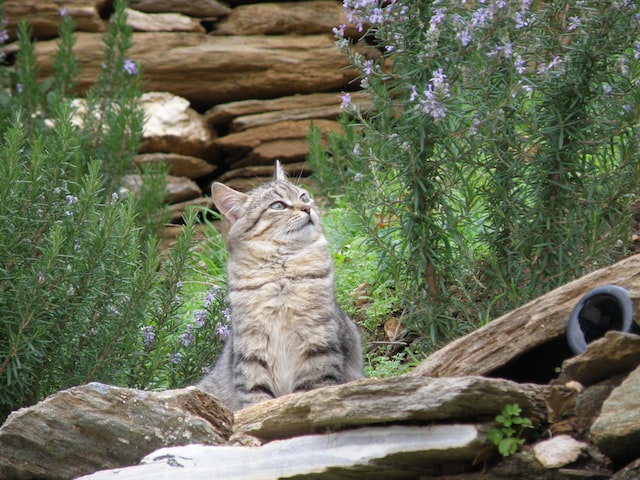Cats peeing in the garden can be an irritation for many. Whether it’s your own cat, your neighbor’s, or even a stray, it’s frustrating and uncontrollable.
Thankfully, there are ways to stop cats from fouling your garden. Unfortunately, not all methods work for every cat.
1. Cat-repellent fences
A cat-repellent fence is one of the best ways to prevent cats from peeing in your garden. This is because it will make cats think twice before trying to climb over it, thus discouraging them from entering your yard.
Many people opt for cat-repellent fencing as a means of keeping stray cats out of their gardens. These systems are highly effective at deterring cats from entering an area and can be easily installed using readily available materials in just minutes.
When selecting a fence, there are three main types to consider: wire, plastic and wooden. Fencing can be an effective deterrent when properly constructed and tall enough to prevent cats from slipping through it.
Feathered plastic roll-up fencing is another common solution to stop cats digging. While this solution will be more successful at stopping cats than wooden fencing, its appearance may not be as appealing to the eye.
Some people use plastic spikes to keep cats from climbing over fences and walls. These are a humane, effective deterrent that isn’t harmful to pets or humans alike.
Spikes can be strategically placed on fences or in certain areas to make it uncomfortable for cats to walk on them. This may deter them from climbing over them or even prevent them from trying in the first place.
Another popular method for deterring cats from entering gardens is using a cat-repellent spray. Not only will these repellents keep stray cats out of your yard, but they will also stop them from harassing birds and other wildlife.
When selecting a cat-repellent spray, it’s essential that you select the product best suited for your requirements. Some are specifically made to deter stray cats while others are designed to discourage dogs from visiting your yard or garden.
Some products contain chemicals which may be hazardous for cats. Therefore, it’s always best to select a repellent specifically designed for this purpose.
2. Orange peels
Orange peels possess a strongly aromatic scent that can be repugnant to cats. This makes them an effective cat repellent as well as an effective tool in keeping your garden free of pet poop.
If you have an outdoor cat and don’t want them urinating or defecating on your lawn, try scattering orange peels in the soil around your plants. The scent of the orange peels will deter cats and dogs from exploring your garden; however, you must do this regularly in order to keep them away for good.
You can also use the peels to make a DIY pest repellent spray that you can use on your plants and flowers to keep bugs away. Simply fill a reusable spray bottle with water, add the peels, then spray on any foliage you wish to keep away from cats or other pests.
One of the great benefits of this spray is that it’s natural, non-toxic, and won’t harm the environment or your plants or pets. Plus, it’s an affordable and convenient way to keep bugs at bay.
Orange peels not only help your garden flourish, but they can also be utilized in compost. When mixed with other ingredients in your compost, the peels create a rich and healthy soil that plants will love.

One way to use orange peels in the garden is as mulch for flower beds and other plants. Simply spread them over soil where you don’t want weeds, then sprinkle with water as needed for a lush green garden.
Make an effective cat-repellent by mixing orange peels with other common household items, like vinegar or coffee grounds. Not only will the peels deter cats from your garden and porch, but they are also an ideal ingredient in DIY pest repellent recipes due to their pleasant fragrance.
Peels are great for your kitchen garden, as they contain essential nutrients that will encourage plants to grow and flourish. Shredded peels can also be scattered around your garden in order to deter animals, insects and slugs from ruining your flowers. Plus, their natural fertilizer properties provide additional nutrition so your plants grow strong and healthy!
3. Toothpicks
The toothpick is an item that seems like it should come naturally to us. We use them after every meal to remove food bits and residue from our teeth, and they come in an assortment of flavors to choose from.
Toothpicks are typically made of wood, though they can also be constructed out of plastic and stainless steel. Due to their small size and ease of handling, toothpicks make excellent kitchen tools as well as versatile home items that can be used for various tasks around the house.
They can be used for many purposes other than eating, such as removing sticky residue from objects, testing cakes and burgers for doneness, reaching into tiny recessed holes in electronics to reset buttons, cleaning between phone buttons or keyboard buttons, and reaching burned-out wicks on candles.
You can also use wooden sticks to deter cats from pooping in your garden by placing them near where they typically do their business. This is an effective way to stop cats from digging up soft soil around flower beds by simply placing multiple sticks spaced a few inches apart.
Another helpful toothpick tip is to poke several toothpicks into the soil around your potted plants to check moisture levels. If it’s dry, watering will likely be necessary before your plants can thrive properly.
Additionally, you can use them to measure the moisture level in soil around a plant’s stem. While this method is less precise, it saves you a lot of time and effort.
To manufacture wooden toothpicks, logs are debarked and cut into long strips. These are then processed through a machine that slices them widthwise into toothpicks. A sifter weeds out any damaged ones before the toothpicks are packaged for storage.
Brazil is the leading exporter of toothpicks worldwide. These often made from bamboo, but can also come in wood or plastic forms.
No matter the material a toothpick is made from, they can damage both enamel and roots of your teeth. Furthermore, they have the potential to chip veneers or crowns and even cause gums to pull away from the tooth root. While toothpicks make great kitchen tools, they should only be used occasionally and with caution.

4. Water sprays
Many cats, particularly stray ones, may decide to explore your yard or garden for various reasons. Depending on the circumstances, they may be searching for food, shelter or a new home for themselves and/or their kittens. Furthermore, they may be seeking an opportunity to mark their territory.
Cats possess an acute sense of smell, making them vulnerable to areas they sense are unsafe. To deter cats from entering a yard, some people spray it with anti-cat smells or pheromones.
Other suggestions include scattering ground cover such as pine cones or mulch around your flower beds. This will keep the area looking tidy while deterring cats from pooping there.
Citrus peels or lemon and lime zests scattered around your flower beds can also serve to deter cats. However, it’s important to remember that citrus peels aren’t permanent solutions; eventually they’ll lose their effectiveness, so you need to replace them regularly.
This technique can be quite effective for protecting a small area of the garden with netting. Unfortunately, it’s not suitable for larger gardens; therefore, if you need to secure an expansive yard, other methods may be necessary.
If you want to protect an area of your garden that’s more likely to be visited by cats, chicken wire along the floor can be used. This deters cats from walking on it and they will find other places to poop.
Some people have reported success with mothballs in their gardens, as they are said to repel cats. It’s important to remember that this will not be an appealing option for cats. Furthermore, using mothballs may cause soil loss of its natural fertility – potentially dangerous!
If you don’t have mothballs on hand, a water spray can be an effective deterrent. For best results, use a hose with a long wand so that the spray can reach the area in need of protection with ease.
